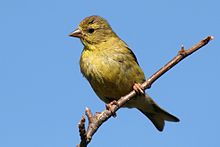
Back حسون أمريكي Arabic Carduelis tristis AST Американска траурна скатия Bulgarian স্পিনাস ট্রিসটিস Bengali/Bangla Cadernera americana Catalan Spinus tristis CEB Čížek žlutý Czech Nico America Welsh Goldzeisig German Amerika kardelo Esperanto
| American goldfinch Temporal range:
| |
|---|---|

| |
| Male | |

| |
| Female | |
| Scientific classification | |
| Domain: | Eukaryota |
| Kingdom: | Animalia |
| Phylum: | Chordata |
| Class: | Aves |
| Order: | Passeriformes |
| Family: | Fringillidae |
| Subfamily: | Carduelinae |
| Genus: | Spinus |
| Species: | S. tristis
|
| Binomial name | |
| Spinus tristis | |
| Subspecies | |
| |

| |
| Approximate distribution map
Breeding
Year-round
Non-breeding
| |
| Synonyms | |
| |
The American goldfinch (Spinus tristis) is a small North American bird in the finch family. It is migratory, ranging from mid-Alberta to North Carolina during the breeding season, and from just south of the Canada–United States border to Mexico during the winter.
The only finch in its subfamily to undergo a complete molt, the American goldfinch displays sexual dichromatism: the male is a vibrant yellow in the summer and an olive color during the winter, while the female is a dull yellow-brown shade which brightens only slightly during the summer. The male displays brightly colored plumage during the breeding season to attract a mate.
The American goldfinch is a granivore and adapted for the consumption of seedheads, with a conical beak to remove the seeds and agile feet to grip the stems of seedheads while feeding. It is a social bird and will gather in large flocks while feeding and migrating. It may behave territorially during nest construction, but this aggression is short-lived. Its breeding season is tied to the peak of food supply, beginning in late July, which is relatively late in the year for a finch. This species is generally monogamous and produces one brood each year.
Human activity has generally benefited the American goldfinch. It is often found in residential areas because it is attracted to bird feeders, which increase its survival rate in these areas. Deforestation also creates open meadow areas, which are its preferred habitat.
- ^ BirdLife International (2016). "Spinus tristis". IUCN Red List of Threatened Species. 2016: e.T22720407A94669207. doi:10.2305/IUCN.UK.2016-3.RLTS.T22720407A94669207.en. Retrieved 11 November 2021.
- ^ Dwight, Jonathan Jr. (1902). "Individual, seasonal, and geographical variations of the American Goldfinch (Astragalinus tristis)" (PDF). The Auk. 19 (2): 149–164. doi:10.2307/4069307. JSTOR 4069307. Archived (PDF) from the original on 4 March 2016. Retrieved 22 February 2013.
© MMXXIII Rich X Search. We shall prevail. All rights reserved. Rich X Search
